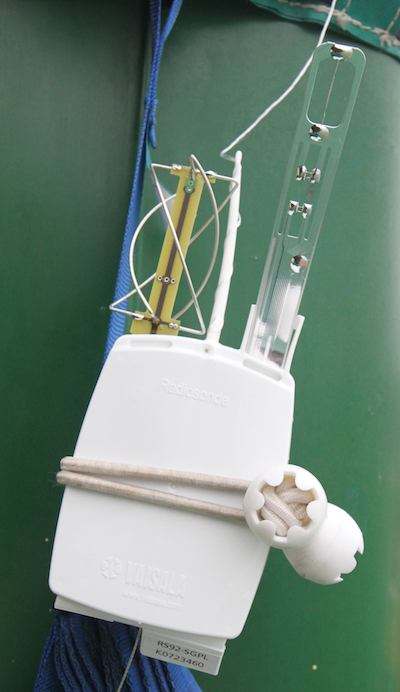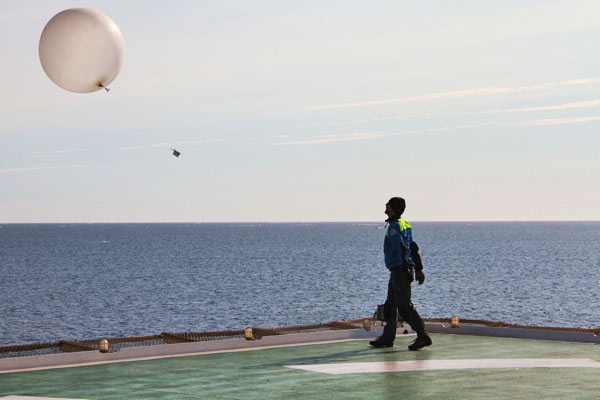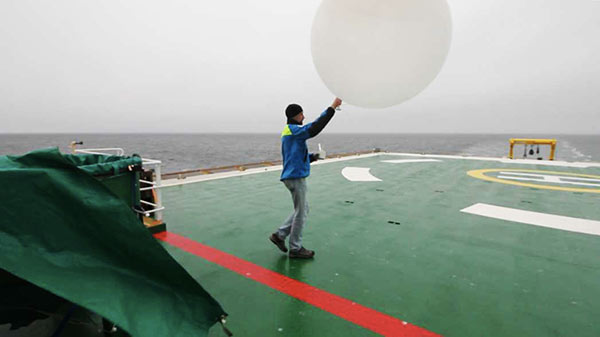|
During SWERUS-C3, I am making observations of methane in the atmosphere. With winds moving air around all the time, how can we place our observations in context? If we measure elevated or depleted methane in the atmosphere above the East Siberian Sea, what does that really mean? Methane has a lifetime in the atmosphere of about 9 years, enough time for a methane molecule to meander to just about anywhere on the Earth. How can a measurement that we make here tell us anything about the local methane effect on such a long-lived gas?
Actually, air doesn’t rapidly mix with other air. Consider aircraft contrails – they do not appear to instantly mix into the surrounding air. Slowly, over many minutes to hours, they diffuse out into the air. (Much of atmospheric physics is based on the idea of “air parcels”, a bunch of air that moves through the atmosphere together.) Because diffusive mixing of air is slow, a higher concentration of a gas can be a sign of being near a source of that gas. The present-day average methane concentration in the atmosphere in the Arctic region where we are is around 1.87 parts per million (ppm). Concentrations above that represent enhancements – perhaps local enhancements.
Talking of air movements brings us to weather. While we can look at local winds to see where the air we are sampling is coming from, another way that we can see where our sampled air is coming from is back trajectories. Back trajectories are a method of looking at the recent past winds in an area, and therefore determining where the air came from. They work to look backwards in time for few-ten days. Further back than that, and back trajectories get iffy. But you can get a general idea of where air has been in the past five days with back trajectories. This helps us understand the history of the air we’re sampling. Did the air recently enter the Arctic region from the Atlantic ocean, or did it come from near the north pole?, for instance.
Even though methane has a 9 year lifetime in the atmosphere, if air has been in contact with a strong source of methane in the past few days (or minutes, perhaps, if it’s in bubbles from a shallow seafloor), the signature of that source – in methane concentration and/or methane isotopologues (see my 5th blog post) – will still be present in the air that we sample. Especially in the isotope measurements, the source signature on the methane can last for many days or weeks.
 So how do we know the past winds needed to create back trajectories? Well, the winds for every place on Earth for the past few decades are stored by weather centers around the world. These wind data feed into the weather models that are used for weather forecasts worldwide. But we don’t measure the wind carefully at every point – most of it is generated by models. But having real data constrains the models (and helps them give better results). So how do we know the past winds needed to create back trajectories? Well, the winds for every place on Earth for the past few decades are stored by weather centers around the world. These wind data feed into the weather models that are used for weather forecasts worldwide. But we don’t measure the wind carefully at every point – most of it is generated by models. But having real data constrains the models (and helps them give better results).
In many places all around the world, four times every day, small weather balloons are launched. They carry small devices called radiosondes which measure the temperature, windspeed, and relative humidity as they rise. They reach about 22 km before the helium-filled balloon lifting them pops. The data radiosondes send back form the basis of atmospheric weather prediction models. While most of the input to these models comes from fixed locations that always launch weather balloons, sometimes moving platforms are included as well.
One of those moving platforms is Oden during SWERUS-C3. Four times a day, our atmospheric meteorology team sends someone out to fill a weather balloon with helium, attach a radiosonde, and release it from the helicopter deck. The data sent by the radiosonde helps with weather predictions for our location. But the data is also sent into the worldwide network of radiosonde data. I know at least that the UK Met Office, SMHI (Swedish Meteorological and Hydrological Institute), and ECMWF (European Centre for Medium-range Weather Forecasts) are using the data from Oden, but it is likely that others are as well. So wind measurements made in the Arctic may, in a small way, improve weather forecasts elsewhere in the world. It’s all the same atmosphere, it just moves around.


Thanks to the meteorology team – Ian Brooks, Matt Shupe, Paul Johnston, Dom Salisbury & Michael Tjernström for talking with me about radiosondes. Mistakes herein about what radiosondes do are mine, not theirs!
|

 So how do we know the past winds needed to create back trajectories? Well, the winds for every place on Earth for the past few decades are stored by weather centers around the world. These wind data feed into the weather models that are used for weather forecasts worldwide. But we don’t measure the wind carefully at every point – most of it is generated by models. But having real data constrains the models (and helps them give better results).
So how do we know the past winds needed to create back trajectories? Well, the winds for every place on Earth for the past few decades are stored by weather centers around the world. These wind data feed into the weather models that are used for weather forecasts worldwide. But we don’t measure the wind carefully at every point – most of it is generated by models. But having real data constrains the models (and helps them give better results).














